One of the reasons that I wanted to start this blog/challenge was to break myself out of the culinary rut that I have been in for the past few months and as well, expand the palate of both myself and my wife. We don't tend to be as adventurous as I'd like to be and I felt that the set of 101 Classic Recipes listed in the 150th issue of Saveur Magazine might just be the ticket. With that, I knew that there were would be many ingredients, a few techniques and a few styles of cuisine that I had never used, attempted or tried.
My next dish, Saag Paneer (Spinach with Fresh Indian Cheese) would take care of two of those at one time. While I have made many things in my life, but cheese is not one of them. I have also never tried Indian food - neither cooking it nor eating it. I was very eager to take a crack at it.
Ingredients for Saag Paneer:
For the cheese:
8 cups milk
1/4 cup fresh lemon juice
6 tbsp. ghee or canola oil
For the spinach:
4 cloves of garlic, chopped
1 1" piece ginger, peeled and chopped
1 serrano chili, stemmed and chopped
6 cups finely chopped spinach
Kosher salt, to taste
6 tbsp. heavy cream
1/2 tsp garam masala
1/2 tsp cayenne
Indian flatbread or rice, for serving
A quick apology, when I made this dish I had a guest in the kitchen and found myself chatting as much as cooking (which usually is my favorite way to cook :-)) and I completely forgot to take pictures at steps I normally would have.
First I set the milk in a large sauce pot on medium high heat until just under a boil, keeping in mind to stir often with a wooden spoon so that it didn't scorch. While a good burnt flavor is desirable in some things (hamburger, steak, creme brulee), it renders other things like popcorn, garlic and in this case, milk, completely inedible in my opinion. While the milk was heating (and in between stirs) I set up a colander in the sink with four layers of cheesecloth on it, edges hanging over the sides.
Once the milk started its lovely pre-boil undulations, I lowered the heat and added the lemon juice to the pot and stirred slowly for thirty seconds while the milk curdled. Once the curds and whey had separated, I poured them into the colander, catching the curd in the cheese cloth. I rinsed the curd in order to remove any lingering lemon juice and tied the corners of the cheesecloth together, gently squeezing out the liquid. I then inserted a wooden spoon and let the cheese drain over the large pot for an hour and a half.
After the hang time, I untied the cheesecloth and overlapped the edges and set it on a plate and set a heavy weight (see cast iron skillet) on it for another 45 minutes.
Below is the cheese that was produced from the squeezing and pressing. In retrospect, while the texture of the fresh cheese is rather addicting, the flavor left a whole lot to be desired. When I try my hand at this again I will better squeeze the curd when in the initial compression stage (mine ended up a bit loose as you can see in the photo) and I will salt liberally with sea salt.
The cheese was then cut into 1/2" x 1" cubes which, as previously mentioned, were a bit loose and fell apart easily.
I poured the canola oil into a non-stick pan over medium heat and fried the cheese in batches.
In over 33 years of cooking experience, I have tried cooking many things, many ways, but I have always had an issue with pan frying. I know that the issue in all likelihood is me, however I like to blame things like the pans I have used, the cook tops, even the spatulas. The issue isn't that I routinely create a fiery train wreck of a meal every time I wield a pan. Instead, I am cursed by the mediocre results. Oh, I can saute a mean onion or mushroom, but when it comes to getting that perfect, crusty, crunchy caramelization on food, I end up pulling up short or going to far and ending up with burnt bits. The browning of the chicken for another of the recipes included in this blog, Chicken with Forty Cloves of Garlic, is a perfect example.
The paneer was no exception. While I tried to let the cheese cubes sit long enough to caramelize and release from the pan, they still ended up sticking and making little bits of burnt cheese. By making the cheese a bit firmer the next time round, I hope to rectify that problem.
As I said though, not a fiery train wreck, just less than optimal (still yummy). Once the cheese had been browned all over, I transferred it to a plate for use later.
While the the cheese sizzled away, I placed the garlic, ginger, chili and 1/2 cup water and pureed. The original recipe states that it should be pureed into a paste, but with that much water, it was not paste like at all. Note to self, next time cut the water in 1/2.
Once the cheese had finished, I returned the pan to medium heat, added the garlic concoction and cooked until "fragrant", about 30 seconds.
I tossed the spinach into the pan, coating with the bubbling liquid and stirred the chopped leaves until they had wilted, then covered the pan and cooked, stirring often, until the spinach was soft about 15 minutes. Though the original recipe does not instruct you to add water while the spinach cooks, I found that over the course of 15 minutes I added approximately a 1/3 cup of water to make sure the spinach
didn't completely dry out and burn.
After the spinach had softened, I stirred in the cream, garam masala, and cayenne, stirring to incorporate fully. I added the previously cooked cheese to the skillet, covered and cooked until the liquid had thickened and the cheese had warmed through, about 15 minutes. I was a bit afraid that the cheese might dissolve or at least begin to break apart, but it seemed to hold together well. I also stirred gently while cooking in order to make sure I did not expedite the process prematurely.
I served the Saag Paneer with brown rice rather than traditional Indian flatbread, but I must say I was pleasantly surprised. While the spinach flavor was evident, it was not overpowering. The garam masala (a combination of spices including cumin, coriander, cardmom, pepper, cinnamon, cloves and nutmeg) presented a spicy match to the earthy spinach and the cayenne delivered a heat that was a slow burn. You didn't really get it on the first bite, but it built from the second, to the third and by the fourth or fifth, you were breaking a sweat. The texture was creamy and smooth, with the slightly crunchy paneer providing a slight change in pace in each bite. My constant companion and trusty taste tester, Kim, was quite surprised with how much she enjoyed it. She noted that while she wasn't a huge fan of spinach, the flavor was good and the heat gave it a nice kick and that she would be in favor of having it again.
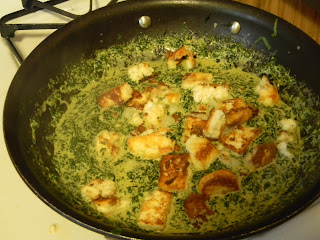 |
| Saag Paneer - Schuler Version |
 |
| Credit: Todd Coleman |
9 down, 92 to go.

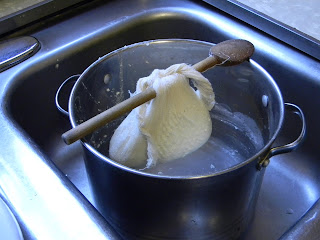
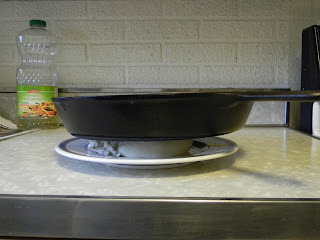
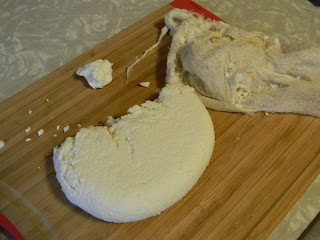




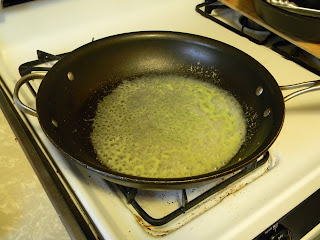

No comments:
Post a Comment